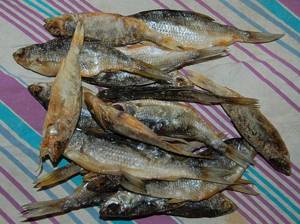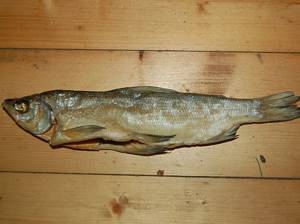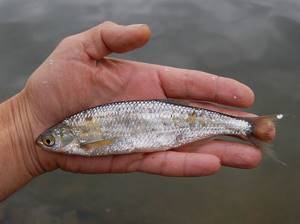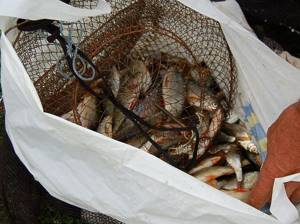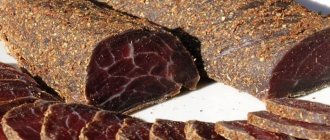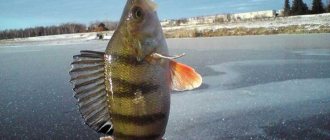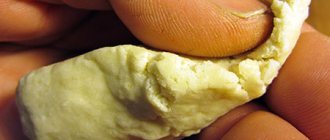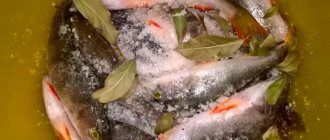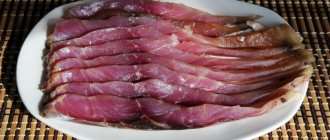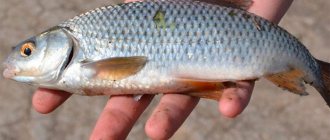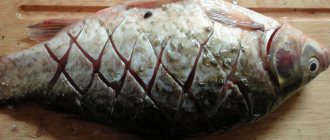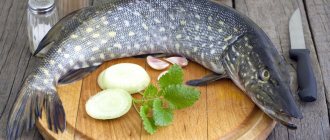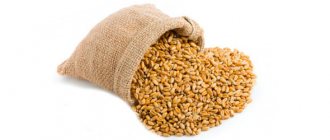Features and benefits of dried fish
Drying is cold drying with pre-salting. In the fresh air, in the sun, under the influence of ultraviolet radiation, the fish becomes dehydrated.
If you just dry it, it becomes flat and hard. During drying, some of the fat is redistributed into muscle tissue. This process makes the fish tasty and healthy.
This product can be stored for six months. It is perfect for those who are on a diet, because its calories are five times lower than those of meat. It contains many omega-3 polyunsaturated fatty acids, which have a beneficial effect on the cardiovascular system, preventing the development of atherosclerotic plaques on the walls of blood vessels.
Dried fish can also be an excellent help in the fight against wrinkles, since omega-3 fats can compensate for the lack of protein in the body.
The product contains a lot of calcium. The healthiest thing here will be small fish that can be eaten with bones. It also contains a lot of fluorine and phosphorus.
Let's celebrate! Scientists have found that omega-3 polyunsaturated fatty acids can have a detrimental effect even on cancer cells. Regular consumption of dried product reduces the risk of cancer and heart attacks.
What fish is suitable for drying?
Smaller species have good taste: roach, ram, sabrefish. You can also take large fish: catfish, bream, pike perch. You can buy frozen versions such as mackerel, halibut, and herring and dry them at home after defrosting.
Roach, bream, pike, ide, and bleak are good for these purposes. The most delicious fish will be fresh fish that was salted on the day of fishing and then dried.
How to prepare fish for drying?
Dried fish is a fish that is first salted and slowly dried in the open air. Due to slow dehydration, the product gradually matures.
Before salting, fish must be thoroughly washed and cleaned. The scales should not be peeled off. Large specimens must be cut and gutted. In this case, you should not touch the skin with scales. And in order to get the insides, you need to make a cut along the back.
Drying in winter
The fish turns out to be appetizing if you catch it in winter or spring, as it contains more fat. In winter it is more difficult to do this, since the normal process takes place in the open air.
Drying fish at home in winter is also more difficult, since the house is warm and drying occurs too quickly. The fish is not as appetizing as in summer. At the same time, a specific smell spreads throughout the house.
But in winter there are no flies, so you don’t need to think about how to protect the product from this scourge. In winter, you need to use the dry salting method. The fish is salted, washed and hung over the stove, near the radiator.
Let's celebrate! In the cold, the product will gradually freeze out. But then the fish will need to be dried in a warm place. It is very good if you have a portable frame box.
Drying in summer
An appetizing fish is obtained by drying it in the summer, when the weather is good:
- The process must take place in the fresh air.
- In the sun, all the valuable fat will flow out of it.
- The fish must be hung so that they are not pressed against each other.
- It is better to place it in the shade, somewhere under a canopy.
- It is advisable to dry small fish horizontally on a mesh.
- When the weather is too hot, you can dry fish in the attic if there is good ventilation.
- You can dry the fish in a cool cellar or on the balcony.
Step-by-step preparation
Fish cutting
- We rinse one yellow-cheeked fish under running water, remove the moisture from it with a paper towel, place it on a cutting board and, starting from the tail, remove the fillet from it along with the scales, trying to run the knife as close as possible near the ridge.
- Turn over and cut off the second part of the fillet in the same way.
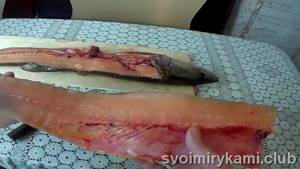
- Having tilted the knife almost horizontally, we pass it near the ribs and carefully cut off the bones, separating them with a small layer of meat from the fillet.
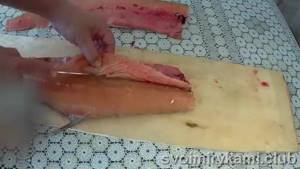
- We cut off the fin along with the bones in a similar way.
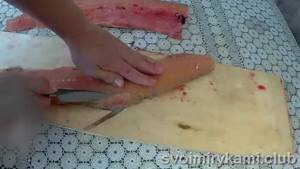
- Approximately 1/3 of the piece of fish meat is cut transversely and we move the knife in a horizontal position near the skin itself, cutting off a clean fillet from it.
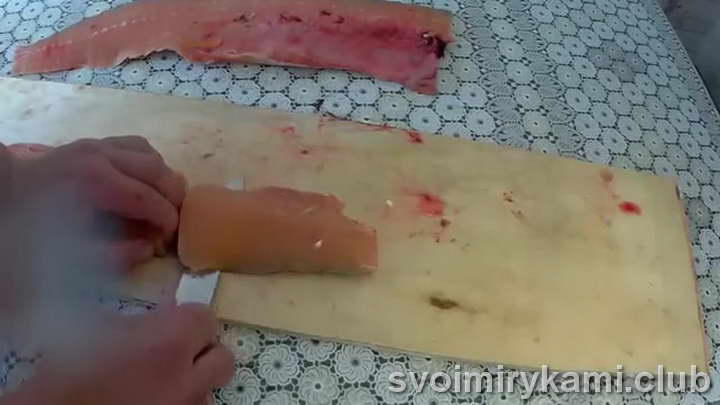
- In the middle of the remaining piece, make another cut and remove the fillet, pressing the skin to the surface of the board with your fingers.
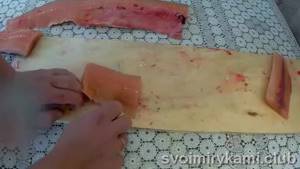
- We also remove the ribs from the second half of the meat and remove the fillet in the same way.

- We wash the resulting 6 pieces of fillet under cold running water and remove any remaining moisture with a paper towel.
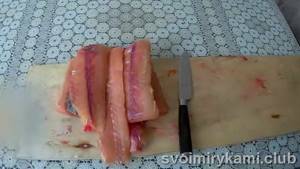
Salting and drying fish
- Pour 2 tbsp into a deep plate. l. chili salt and 2 tbsp. l. salt with herbs, then mix them with a tablespoon. Add 3 tbsp to the mixed salt. l. sugar and mix again. Add 3 tbsp to the ingredients. l. red sweet pepper and thoroughly mix all bulk products.
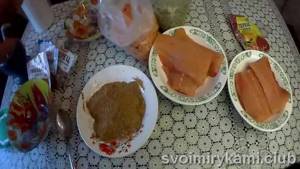
- Put 5-6 cloves in a mortar, 1 tbsp. l. peas of coriander and 5-6 peas of black allspice, then lightly grind with a pestle until large pieces are obtained.
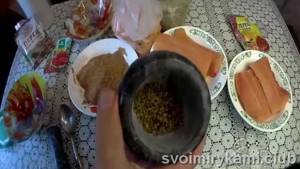
- Add the resulting mixture to a deep plate with salt and mix everything again with a tablespoon.
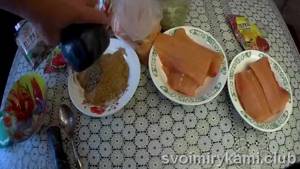
- Take 1 piece of fillet, dip it in the resulting mixture, press down lightly, turn it over and immerse the fish on the other side, press down a little again, then take it out, shake off the salt a little and put it in a deep plate.
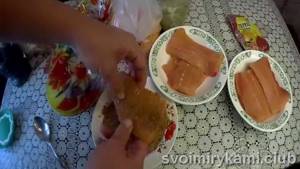
- Repeat the process with the remaining 5 fillet pieces.
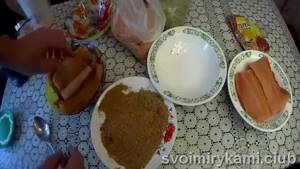
- Pour the remaining salt and additives into a jar, close the lid tightly and leave for next time. Leave the fish in the plate for 2 hours.

- After 2 hours, scrape off the remaining salt with a teaspoon, hook the meat and hang it on the balcony for 2 days.
- After 2 days, remove our dried fillet and cut the meat along the ridge line into strips approximately 0.5 cm thick, then divide them into strips.
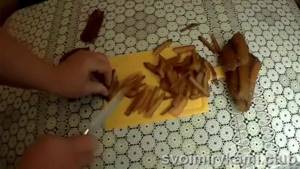
- We spread the resulting fish straws in an even layer on a sheet of baking sheet and again send them to the balcony to dry for 3 days, while about once every 3 hours throughout this time we lightly stir the chopped fillets so that they do not stick together and dry evenly.
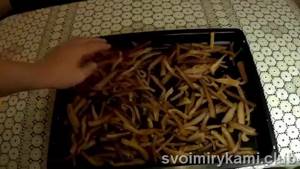
- After 3 days, pour the finished dry dried fish into a deep container and serve.

For lovers of spicy dried fish, add 20 g of red chili pepper to the salt, then mix all the ingredients, roll the fish in this mixture, put it on a plate and leave to marinate for 4 hours. The further process of drying the fish is no different from that described above.
Pickling recipes
The dishes are glass or plastic. At the same time, dehydration of the fish proceeds slowly, which is absolutely necessary in this process. There are several ways to pickle:
Dry salting
Suitable for large specimens weighing more than 1 kg.
- The fish is cut along the back and the insides are carefully removed.
- Clean the inside of the carcass with a damp cloth.
- Sprinkle the internal cavities generously with salt.
- Cover with a flat lid.
- They put oppression.
For 10 kg of fish you need 1-2 kg of salt. The fish will be salted for 3 to 12 days. Oppression is needed to release air bubbles that contain bacteria. During the pickling process, juice will begin to release. It will flow down through the cracks of the box. That is why this method of salting is called dry.
Let's celebrate! If you need to salt a lot of small fish, then the insides are not removed. It is best to spread a cloth, place the fish on it, sprinkle with salt and wrap it in this cloth. The fabric will let juice through if you put some kind of weight (oppression) on top.
Wet
Most often, small fish is salted wet:
- The bottom of the selected dish (pan, basin, etc.) is sprinkled with salt.
- Place the fish in layers as closely as possible.
- Sprinkle each layer with salt
- The top layer is also generously sprinkled with salt.
- Oppression is placed on top.
Note! After a couple of days, brine will appear on top of the last layer. During salting, the container must be placed in the cellar so that the meat does not spoil. A refrigerator is also suitable for these purposes. In camping conditions, you can dig a hole in the ground. When salting using the wet method, small specimens are salted very quickly, in just a day or two.
Provesny
- Prepare a solution at the rate of 3-3.5 kg of salt per 10 liters of water.
- Pump the solution into the belly of large specimens with a syringe.
- Thread the fish onto twine.
- Immerse completely in the solution.
Pink salmon
- Time: 2 days.
- Number of servings: 8-10 people.
- Calorie content of the dish (100 g): 182 kcal.
- Purpose: snack.
- Cuisine: Russian.
- Difficulty: easy.
If you often have guests or organize long gatherings with friends, then be sure to pay attention to this simple recipe. The delicacy is excellent consumed alone or with an intoxicating drink. Pink salmon is not too fatty, so it is suitable for those who are watching their figure. Balyk is delicious to eat with bread and vegetables: you can form canapés and sandwiches.
Ingredients:
- pink salmon – 1.5 kg;
- salt – 3 tbsp. l;
- sugar – 1 tbsp. l.;
- spices - optional.
- Chicken with mushrooms in sour cream sauce: recipes with photos
- Child benefit
- How to open a bottle of wine without a corkscrew
Cooking method:
- Defrost, rinse, cut the carcasses into plates.
- Combine salt, sugar, spices. Sprinkle the mixture over the meat and stir. Leave everything for a day.
- Place the pink salmon on a baking sheet and place in the oven at a temperature of 40 degrees for 4-6 hours. The oven door must be open.
- The finished delicacy is cooled in the refrigerator and then served.
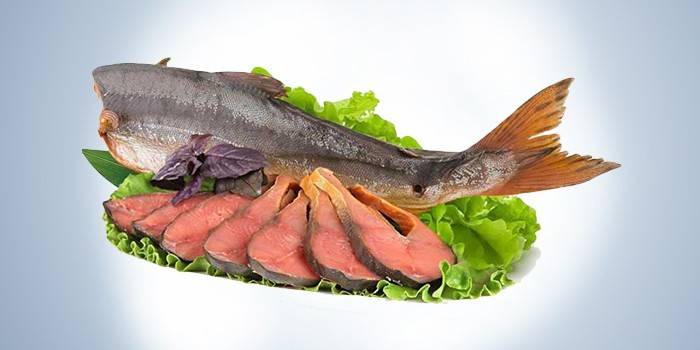
Soaking the fish
To reduce the salt content in the outer layers of fish meat, soak it. The soaking process must be approached responsibly. This is done so that the already dry fish does not become damp during storage.
You should soak only for hours, how many days did the salting last:
- Place the fish in a container with water.
- Every few hours they take it out for the same amount of time, then put it back.
- When it floats to the surface, it is taken out.
Cutting methods for drying
- Uncut;
- Uneviscerated, headless;
- Gutted with the head;
- Frozen, that is, the gills have been removed;
- The layer is headless;
- Layer with head;
- Half-layer;
- Back-beam;
- Bokovnik.
Small fish can be left uncut or chilled. For example, roach, crucian carp, rudd, roach, ide, mackerel, mackerel, herring, perch.
Large raw materials must be cut. Then the fish must be salted using dry or mixed salting until the salt content is at least 6% in the thickness of the meat. This process may take about a week. The next operation is soaking. It is needed to prevent brine—salt deposits—from appearing on the surface of the finished product. Depending on the size of the carcass or its parts, the fish is kept in clean water or a weak solution of brine for 1 to several hours.
Drying fish
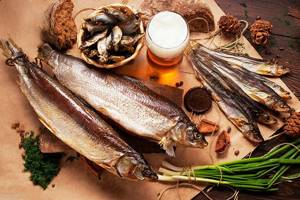
The ideal temperature is considered to be 18-20 degrees. The drying process is carried out to dehydrate the product.
The moisture content of the tissues should be less than 40% to prevent the development of bacteria and yeast. When moisture is removed, the specific smell characteristic of this type of fish intensifies.
Note! From fatty fish such as carp, bream, flounder, mackerel, etc., moisture is removed very slowly. It needs to be dried for a long time and patiently.
How to deal with flies when drying fish?
In summer, the problem of insect control becomes acute: flies and wasps. They immediately gather the smell, crawl on the skins, and eat meat. And flies also lay eggs, from which maggots quickly appear.
Note! Therefore, in the summer, the fish should be hung in the evening, at night. If drying occurs during the day, then you can hang the fish with a net.
How to determine if fish is ready?
To determine the drying time of the product, two factors must be taken into account:
- Air temperature and humidity.
- Fish size.
Small fish can dry out in two to three days. Average for a couple of weeks. Large specimens require at least a month. The easiest way to determine the readiness of a product is by taste.
There are several signs by which you can visually judge readiness:
- Well-dried fish is dense, can be translucent, and has a greasy sheen.
- The skin will be tough and come off very easily.
- There are no salt crystals on the scales.
- The product emits a pungent odor.
Dried fish at home: recipes
For a lover of a very tasty and equally healthy treat, the safety of this snack is certainly important. So, cooking it with your own hands, drying fish at home is a pleasant process that brings pleasure. There are many recipes that can be used to prepare a delicacy for any carcass.
Dried carp
Dried carp has a very special taste. Before salting, it is necessary to gut it, remove the head, gills and tail, clean the scales and rinse thoroughly. Then you need to salt the carp in one of two ways: “dry” or “wet”.
Required:
- Carp carcass - 5 kg.
- Water - 0.5 l.
- Salt - 125 g.
- Food saltpeter or aspirin (always take 2% by weight of salt).
Note! Salting lasts 10 days. After this, the carcasses are washed and again lightly salted with food nitrate or aspirin. The carp are then hung and dried for two to three weeks. Properly dried carp can be stored in a cold room for a year.
Dried pike
Before drying pike, it must be gutted and washed. If the pike is large, it is advisable to cut the back so that the drying process proceeds evenly:
- Medium pike - 2 kg.
- Salt - 5 tablespoons.
- Butter - 150 g.
- Straw - a bunch.
- Rye bread crusts - 150 g.
Sprinkle each pike carcass generously with salt outside and inside. Then we place them in a suitable container on a layer of salt. We leave the pike to salt for 2 days. Then the carcasses are washed and dried on towels.
When the fish is dry, insert pieces of butter into the slits on the back. Place straw on a baking sheet and pike on top. Place in the oven. The pike will wilt in 10 hours. At a temperature of 80-100 degrees. The oven door should be kept open 4-7 cm.
Dried roach
This is a national delicacy. The bottom of a suitable container is covered with coarse salt. The roach is laid in layers, covered with salt. Then they place the load.
After three days, leave the fish for a couple of hours under cold running water. Then the roach is collected into bunches according to the size of the carcasses, 12 pieces each. In a few days the roach will be ready.
- Vobla - 9-10 kg.
- Salt - no more than 1 kg.
- Sugar - 1-2 teaspoons (for those who like a spicy taste).
How to make dried fish?
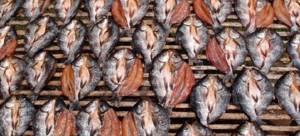
The essence of the process is slow drying under the influence of heat, light and air. This leisurely method leads to an even distribution of fat and even partially changes the composition of the product - it acquires a rich color and dense texture. Before drying the fish, you should salt it - the main stage of preparation.
Ingredients:
- fish;
- salt – 150-250 g.
Preparation
- Sort the carcasses. Gut the large ones, and leave the small ones in their original form.
- Rinse, dry slightly and proceed to salting.
- For a mild taste, use 150 g of salt per 1 kg of pulp, if desired, increase the amount of the first.
- Sprinkle with salt and place the carcasses in layers in a convenient container.
- Place the workpiece under pressure in the cold for 3 to 14 days, guided by the weight of the product.
- Thread the carcasses onto twine, passing the needle through the eye sockets.
- Form bundles of 6 units, rinse and hang in a cool and ventilated place, covered with gauze.
- Dried fish takes no more than 14 days to prepare.
Dried fish in the oven
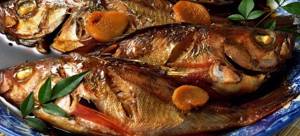
Dried fish is a recipe that involves various drying techniques. The natural method of harvesting in an open space is ideal for country residents. The artificial method involves special production smokehouses. Simple and universal tips will tell you how to dry fish correctly, paying attention to the weight and type of product.
Ingredients:
- fish;
- salt.
Preparation
- If you are the owner of small fish, then cook it whole; large fish should be gutted.
- Lay out the fish in layers, sprinkle thoroughly with salt and place under pressure.
- After a short daily salting, rinse the carcasses, make cuts over the entire surface and secure them with toothpicks so that the fish does not steam and is ventilated.
- Set the oven temperature to no higher than 40 degrees, turn on convection and open the door.
- Place the product on a previously lined baking sheet and place in the oven for 7 hours.
- The slightly open door ensures ventilation of the workpiece, and the low temperature conditions ensure uniformity.
- Keep the dried fish in the air for 24 hours, then take a sample.
Dried fish sabre
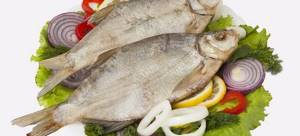
The inhabitant of the carp family is extremely in demand by fishermen and, therefore, is listed in the Red Book. Juicy meat, dense subcutaneous fat and optimal size make it an attractive product. Dried fish, the recipe for which includes two salting options, requires strict adherence to the preparatory steps.
Ingredients:
- fish;
- water;
- salt.
Preparation
- When starting pickling, choose a method in advance.
- When dry, the product is placed in a wooden container and, generously sprinkled with salt, is placed under pressure.
- Wet - involves brine for dried fish, at the rate of 1 kg of salt per 3 liters of water. After 5 days, check for readiness, rinse and soak for a day, after which, dry and traditionally hang the workpiece in the right place.
Dried red fish
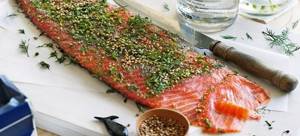
Dried red fish at home is a great opportunity to pamper your loved ones at any time of the year. You don’t need to have fishing gear to prepare the delicacy - the range of stores is quite suitable. Use fatty fish, such as salmon and trout, and homemade fish will remain juicy and flavorful for a long time.
Ingredients:
- trout;
- salt.
Preparation
- Large trout are gutted, the head is cut off and divided into two halves for convenience.
- You can’t do without pre-salting, so rub the carcass generously and, covering it with film, place it in the refrigerator for two days.
- Wash, dry and hang upside down for 5-10 days.
- The readiness of dried fish is determined by taste preferences.
How to dry small river fish?
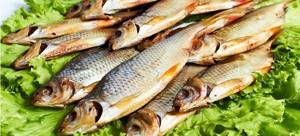
Experienced fishermen often encounter large catches. The most common small-sized river inhabitants - roach, goby and roach - are suitable for instant salting, and then for drying. Fresh fish does not require gutting, soaks quickly and is easy to store. This snack will harmoniously complement the foamy drink and diversify the menu.
Ingredients:
- fresh roach or gobies;
- salt.
Preparation
- Wipe your fresh catch dry with a towel.
- Pour salt into the bottom of a deep enamel bowl and place the first layer.
- Salt each row generously, then cover it with a plate, place a weight and put it in the cold.
- After 3 days, hang the soaked product in a ventilated area.
- Making dried fish is a process that requires a week of drying.
How to store dried fish?
Drying fish at home is not difficult. Time after time, experience accumulates, which helps to obtain a fragrant delicacy. You should know how to store it so that it does not spoil.
The fish is stored at a temperature no higher than 10 degrees. It is convenient to store the product in the refrigerator in the apartment. The carcass should be wrapped in paper.
You can also store it in a ventilated attic or on a balcony. Each fish must be wrapped and placed in a wooden box. If there is no box, it is recommended to use a linen bag.
How to dry fish correctly
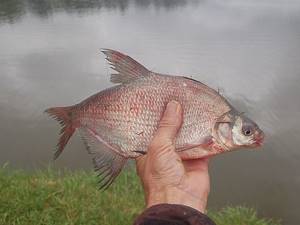
During the drying process, complex biochemical processes occur in fish meat, as a result of which the fish is not only dehydrated, but also ripened.
For good and rapid ripening of fish, light, fresh air and warmth are necessary.
The best conditions for drying are created in the spring, when the air temperature is low and there is a lot of oxygen and ozone in the air.
But in autumn the fish is fattier and the catches are higher. That is why caravans of cars are now heading to the lower reaches of the Volga.
As an example, consider the scheme for preparing dried roach.
The process consists of the following operations: catching fish, storing it, sorting, washing, salting, washing, stringing fish, hanging, drying, eating, sorting, packaging and storage.
Live or recently caught fish are sorted by size, washed to remove mucus with cold water and sent for salting.
Salting is done using a mixed method. Brine (salt solution) with a density of 1.16-1.20 g per cubic cm is poured into the bottom of the salting container in an amount of 20-30% of the weight of the fish. The fish are placed in a container in rows, sprinkling each subsequent layer with salt.
Read the material “Looking for an asp on the Klyazma”
Less salt is poured onto the lower rows of fish, and more salt onto the upper rows. The topmost row is covered with a layer of salt 1-1.5 cm thick. The total salt consumption is 13-15% of the weight of the fish.
To ensure even salting, stir the fish after a few minutes. The duration of salting a large roach is 3-6 days, and a small one is 2-3 days.
After salting, the fish is washed in fresh, cold water to remove salt from the surface of the body, as well as to remove possible excess salt in the body of the fish.
After this, the fish are threaded onto a string through the eyes using a needle (pin) so that the bellies of all the fish are directed in one direction. It is better to string no more than 15 individuals onto one thread of twine. The strung fish is hung on racks or special hangers.
The duration of drying depends on weather conditions, the size and fat content of the roach. So, a large roach will be ready in 17-30 days, and a small one in 13-15 days.
|
| Dried fines. Photo: Andrey Yanshevsky. |
The readiness of the product is determined organoleptically. The roach meat becomes very dense and acquires an amber color; when pressed, fat appears on the cut. The taste of dried roach is slightly bitter.
After determining the readiness of the product, the fish are removed, disassembled and tied in 40-50 pieces of the same size and variety. After this, the tied roach is packed in gunny bags or wooden boxes.
The finished roach should be stored in a cool, dry place at a temperature not exceeding 10 degrees and a relative humidity of 70-75%.
Read the material “Mushroom Mix”
The technology for preparing dried bream is somewhat different from preparing roach (roach).
Fish up to 25-28 cm in size are salted uncut; larger specimens are pre-gutted. Before salting, the fish is thoroughly washed to remove mucus; large fish are pre-cooled to zero degrees.
Salting of bream is done using a mixed method, that is, using brine and dry salt. The duration of salting depends on the size of the fish.
|
| Dried peled is a very tasty product. Photo: Andrey Yanshevsky. |
Large, cut bream and small uncut bream are salted for 4-5 days, and medium uncut bream - 5-6 days. After salting, the fish is removed from the brine and kept in a separate container with water to equalize the salt concentration in the meat. After this, the fish is washed.
The washed fish is strung on string and hung on racks. Further, the entire drying process is similar to the process of drying roach.
Drying small fish
Fresh, small fish such as smelt, small perch, roach and bream are washed in water. Salting is carried out in brine with a density of 1.2 g per cubic meter. cm. The duration of salting is 7-15 minutes.
After salting, the fines are washed to remove brine. Dry small fish on floors or nets. The fish is scattered on a net in one layer. The duration of drying is 2-7 days.
Drying perch and small pike
Dried perch and small pike are a true delicacy for many fish lovers. Although many do not like their fibrous, lean and relatively dry meat. It is better to dry perch in a way that is similar to the method of preparing small fish.
There is only one subtlety, which is that it is better to hang the fish upside down so that the dripping fat does not disappear, but remains in the fish. The same applies to drying other types of relatively low-fat fish.
Drying pike has become dangerous in recent years due to its heavy infestation with parasites.
Preparation of dried balyk products
Dried balyk products are made from large and plump fish: sturgeon, nelma, salmon or catfish.
The technological scheme consists of the following operations: cutting, washing, salting, soaking, washing, tying with twine, drying, sorting, packaging and storage.
The fish is cut into balyk and tesha. This type of cutting is used in the preparation of smoked and dried products from sturgeon and large salmon fish, as well as in the production of smoked and dried products from other types of fish (perch, whitefish, asp, large herring, carp and catfish).
|
| Bleak is traditionally “disposed of” in dried form. Photo: Andrey Yanshevsky. |
The fish is cut along the belly and all entrails are removed. The head is then cut off and the dorsal fin is completely removed without exposing the dorsal fat deposits. After this, the ventral part (carcass) is separated from the back by a cut from the head to the beginning or end of the anal fin at a level slightly below the spine.
The back and carcass, separated in this way, are cleaned of any remaining entrails, abdominal membrane, or blood clots.
Read the material “Liver like a hunter”
Sturgeon and Pacific salmon can also be cut for flanking. The fish is cut in the middle of the abdomen, the entrails, abdominal membrane, and blood clots are removed. The head and all fins are separated, after which the carcass is cut along the back into two identical halves (sides), removing the spine. After this, you can divide the sides into balyk and tesha.
If the bala fish is frozen, then it is cut in a frozen state.
The fish is washed in cold water, rubbed with salt and placed in rows in a salting container with their backs down. A layer of salt 2-3 cm thick is poured onto the bottom of the container and between the rows of fish.
Tesha is salted separately. The total salt consumption is about 40% of the weight of the fish. It is very good if it is possible to add crushed ice to the fish covered with salt, in an amount of about 15% of the weight of the fish.
After a day and a half, cold brine is poured into the salting container. After this, the duration of salting of balyks ranges from 17 to 30 days, depending on the size of the fish and temperature. At the end of salting, the fish is washed in brine and left for 2-3 days in a cold room to distribute the salt in the body of the fish.
To soak, the fish is placed in a bath and filled with fresh water at a temperature of 4-6 degrees. Soaking is carried out to desalinize the surface layer of fish in order to avoid the formation of “brine”, that is, a deposit of salt on the surface of the fish during drying.
The duration of soaking ranges from five hours to two days. The soaked fish is tied with twine and left for 2-3 days to drain the water. A wooden spacer is inserted into the upper part of the meat across the body to prevent the meat from curling up during drying.
Industrial drying of balyk products is carried out on special towers 6-10 m high with a roof and walls in the form of blinds. The beams are hung on hooks driven into the beams.
|
| A standard catch that will be used for home drying. Photo: Andrey Yanshevsky. |
The duration of drying of balyks is 10-30 days, depending on the ambient temperature and humidity. The duration of drying the meat is no more than 10 days. In winter, the process of natural drying is combined with artificial drying in a chamber at a temperature of 6-8 degrees. In this case, the duration of drying increases to 1.5 months.
Read the material “Tables and wallets are scarce without sprat...”
The readiness of the product is determined organoleptically: the cut meat should be light yellow, elastic in consistency, soaked in fat and have a pleasant, delicate smell and taste.
Finished balyk products are packaged in clean wooden boxes lined with parchment inside. Ready-made products should be stored in a dry, well-ventilated area at a temperature not exceeding 10 degrees and a relative humidity of not more than 75%.
In such conditions, balyk can be stored for about three months without loss of quality.
In industrial conditions, tunnel installations are used for drying fish. The drying process in this installation lasts 96 hours under any weather conditions. It is important not only to cook the fish. But also preserve its taste and nutritional qualities.
The defects of dried fish include high humidity, subcutaneous oxidation of fat, sour smell of meat, dampness, mustiness and saponification.
Increased humidity of fish occurs due to violation of storage conditions in rooms with high humidity. With this defect, the abdomen becomes limp, and the muscle tissue swells and weakens. The defect is eliminated by drying the fish.
Subcutaneous fat oxidation occurs when fish that has been stored for a long time is used to prepare dried goods. The vice cannot be eliminated. And most of the “roach”, which is sold in Moscow, suffers from this defect.
The sour smell of meat appears as a result of violation of the fish salting regime, as well as when the fish is excessively desalinated during soaking and washing.
Dampness is characterized by the presence of the taste and smell of raw fish, which manifests itself when the fish has not been sufficiently salted or dried. The disadvantage is eliminated by additional drying of the fish.
Mustiness and saponification are characterized by the presence of a whitish, slippery coating and musty odor, usually on the surface of the balyk product. These defects arise when storing fish in poorly ventilated areas and are eliminated after washing the fish in a weak brine and drying it.
Andrey Yanshevsky October 18, 2021 at 08:17
Reviews
I love very dry fish. It is stored very well. You can wrap it in a wet cloth for several hours, the fish will become softer. But this is not for everyone. Grade:
Nikolay V., Moscow
In the fall I catch chubs and dry them. This is something. I haven't eaten anything tastier. Shemeya is still beyond any competition. Very tasty. But you need to under-dry the perches a little, I know from experience. Grade:
Vladimir D., Saratov
I have two containers for pickling. I place them one inside the other with a gap of 2 cm. There is a hole in the top for the brine to drain. I don't use oppression. I just put these containers in the refrigerator for 3 days. Then I wash and soak for 6-8 hours. Then I dry the fish. Always a great thing to go with beer. Grade:
Mikhail L., Amursk
I dry fish often because I am an avid fisherman and a fan of ramming. The most delicious dried fish is autumn fish, which has already gained fat and dries slowly. Grade:
Vasily L., Volgograd
I put the fish in a wooden barrel in a salt solution. I keep the product like this for three days. The fish is dried for 15 days. The taste is excellent. Grade:
Ilya S., Ryazan
Note! Drying fish at home is quite easy. Store-bought fish contains many chemical additives and various preservatives. Therefore, a product made with your own hands is natural and healthy, and also has an unsurpassed taste and aroma.
Procedure and features of salting fish
Salting in brine
The fish is coated with salt and placed in waterproof containers in layers, adding salt between them. The resulting brine should cover the roach. In the case when the roach remains uncovered for 3-4 hours, you need to add saturated brine to completely immerse it. The fish is covered with a lid that will hold it under the salting surface.
Many salting methods use a saturated brine. The presence of impurities reduces the actual salt concentration in the solution. In fact, brine saturation varies from 80 to 100%, which is approximately 270-360 g per 1 liter of water. When placing fish in a saturated brine, its concentration decreases after the salt penetrates into the fish tissue and the water is drained. With a lack of brine, the saturation of the fish is significantly reduced.
Double and dry pickling
Should not be used in hot weather because the fish is not covered with brine, so it spoils faster and attracts insects. The roach should be quickly filled with saturated brine and left under the lid until salting is completed. Dry salting is the easiest, because in this case you simply rub salt into the fish. Then the roach is placed in a container and left in the refrigerator for several days. Already salted roach is placed on hooks and dried for several days, depending on the time of year.
The amount of salt required depends on the salting method and the amount of fish. To obtain highly dried products, you need approximately 30 kg of salt per 100 kg of roach.
